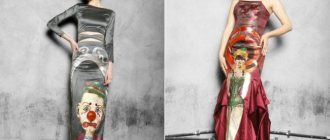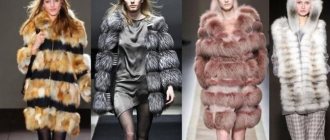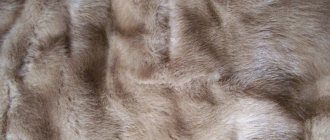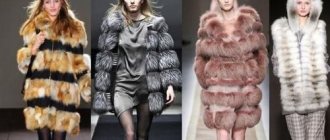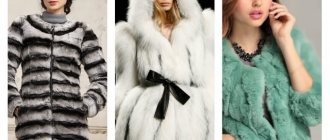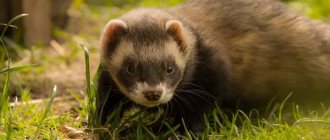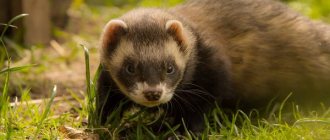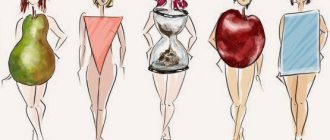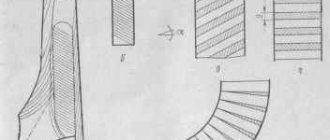Home / Fashion and style / Fur coats
In Europe, muskrat fur coats have not gone out of fashion for a long time and are always presented in the catalogs of leading fur manufacturers in the category of products available to the general consumer. European fashionistas appreciate them for the optimal combination of affordability, variety of product range and large selection of colors shown in the photos of fashion catalogs.
What you need to know about muskrat coats
The muskrat lives in water and on land, so its skin protects it from cold, wind and moisture. The muskrat fur coat, photos of which can often be found in the catalogs of famous fur companies, is distinguished by its impeccable appearance. The animal's fur is smooth, soft and even. It is suitable for coloring, cutting and plucking. The soft and flexible core allows you to sew products of different silhouettes. The variety of processing methods and subsequent processing makes it possible to create a wide range of silhouettes and models. Designers love this fur, which allows you to create a beautiful fur coat in a variety of silhouettes and styles.
Thanks to the combination of muskrat fur with other types of fur, it can be used to sew fashionable models that are in demand on the market for everyday wear. The low cost of women's muskrat coats allows you to create a small collection of practical and attractive products in your wardrobe for all occasions. Due to the affordable price, you can purchase a spectacular floor-length muskrat fur coat or coat without fear that it will quickly become unusable, worn out and bald at the hem.
Muskrat fur and winter hats
Natural fur has always been popular in Russia and today, despite climate change and consumption, fur hats, fur coats and other products are loved in Russia. Mink fur is especially popular. But it’s not just mink that is used to make hats and fur coats. The muskrat has the same soft and cozy fur, which is very similar to mink, and not everyone can distinguish a muskrat hat from a mink one.
Origin of muskrat fur
The muskrat is a mammal very similar to the common rat, although it is noticeably larger than the gray rat. The weight of an adult animal can reach up to 1.8 kg, but more often muskrats weigh 1-1.5 kg, body length - 23 - 36 cm. The tail is approximately the same as the body length - 18 - 28 cm. The fur of the muskrat is thick, lush and dense. The animal loves to preen itself - it constantly looks after its fur, combs it and lubricates it with fatty secretions.
The muskrat leads a semi-aquatic lifestyle. The muskrat's blood contains a high content of hemoglobin, due to which additional reserves of oxygen are created in its body, which allows it to dive into water.
The shores of ponds and swamps in North America are considered the homeland of the muskrat. The animals were brought to Europe in 1905. Now their habitat has expanded; muskrats live in Eurasia, Mongolia, China, and Korea. The muskrat began to settle in Russia in 1927 and quickly spread throughout our country.
In the 70-80s of the last century, breeding muskrats in the USSR was very popular. Now this business is not thriving for us yet. In central Russia, climatic conditions are similar to those in the muskrat’s homeland, so breeding these animals in our country is a very profitable business. The animals are quite unpretentious and are highly fertile - each pair can produce up to 20 animals in two or three litters per season.
Muskrat in the fashion industry
Many fashion houses purchase muskrat fur only at the Canadian auction, where it is represented by the best and highest quality varieties. Wherever the animals are bred, fur from North America, the homeland of the muskrat, is still the best, and is considered a local landmark.
Furs from the North-Eastern regions of Canada are sold under the GMVF brand at international fur auctions as exclusive lots. Fur in these territories is a significant part of the economy. Russia has the same climatic conditions. And if earlier muskrat breeding was popular, now the skins are mainly obtained only through hunting the animals, which has recently caused a decrease in the number of individuals.
The best fur is considered to be the fur of muskrats from Yakut reservoirs. I would like to hope that farms breeding this fur-bearing animal will be more significant not only in the field of fur production, but also in the country’s economy. After all, Russia has the richest fur base.
Properties and qualities of fur
The muskrat's fur is quite thick, dense and lush, which makes it waterproof, because the animal leads a semi-aquatic lifestyle. The color can range from light beige to dark brown and completely black. Black color has the greatest value. Muskrat cubs are dark gray in color; from the second month of life they begin to turn brown; by five months a permanent color is established. The color of a muskrat depends on its habitat, the age of the animal and the time of year. In summer the fur becomes lighter.
In terms of wearability, the muskrat occupies an average place among all fur-bearing species. If the fur of otter, Kamchatka beaver and wolverine is considered the most wearable and is taken as 100%, then muskrat fur has a wearability of 45%.
All products made from muskrat fur can be sewn very well and with high quality: fur coats, jackets, vests, hats, etc. A muskrat coat can be safely worn for five seasons (for comparison, a mink coat can be worn for 10 seasons).
Muskrat fur in products is very similar to mink fur. To distinguish one from the other, you need to know that mink fur is smoother, softer and silkier. In addition, the mink has a thick undercoat and smooth, shiny guard hair. But muskrat fur is beautiful and unique in its own way. Therefore, buyers with average incomes can easily purchase muskrat fur coats.
Muskrat fur is warm and light, beautiful and dense. In a muskrat fur coat, you can get caught in the “accidental rain”, and it will not deteriorate. With good technological treatment, fur coats can be worn for more than five seasons - 6-7 seasons.
The processing of muskrat skins goes through all the same stages as other types of furs. Muskrat fur can be dyed, but most often leave the natural color. If desired, you can find painted muskrat products, ranging from pastel to bright shades. Blue and gray shades are very popular in products.
The quality of fur can be checked this way: after creasing, the fur should quickly take its shape, the hairs should not break or change shape. Muskrat fur looks rich and high quality.
In fashion houses, Canadian muskrat fur is most often used to make fur coats. In addition to fur coats made from Canadian muskrat, which are expensive, fur coats made from Czech muskrat, which are available in Russian stores, are of high quality and have a fairly reasonable price.
Muskrat fur coats are made from the shortest to the longest. The collar or hood is sometimes made from a different fur, which gives the model even more originality and beauty. Designers use both dyed and sheared skins. Interesting and unusual models combine cropped muskrat with leather.
Finally, muskrat fur is used to create magnificent headdresses. Particularly interesting are models made of knitted fur, where muskrat fur in combination with other types creates a luxurious headdress. The thickness and density of the fur will effectively protect you from frost and cold winds.
As mentioned above, muskrat fur is very similar to mink fur, and this explains its popularity among buyers. In addition to beauty, muskrat fur is practical and very pleasant to the touch. Products made from muskrat tolerate wet weather well. A fur coat for every woman is the height of luxury, and a fur coat made from muskrat fur will confirm this.
Muskrat fur: why is it so good?
High-quality winter muskrat fur (the photo demonstrates this well), thicker and denser than the skins of the summer season. It is quite warm and elastic. To look elegant and stylish in winter, you don't need to spend a lot of money on a mink coat. A beautiful women's muskrat fur coat will keep you warm in the cold and allow you to be in fashion without spending a lot of money.
The quality of the fur of this animal optimally matches its affordable price. It is not afraid of moisture and plays different shades in the sun. In the winter version, it has a thick undercoat, giving the fur coat a luxurious appearance. In such clothes, a fashionista does not risk freezing even on the coldest days of winter.
Muskrat fur
Muskrat - musk rat
The muskrat, or musk rat (lat. Ondatra zibethicus) is a semi-aquatic mammal, the only species of the muskrat genus, a subfamily of voles, an order of rodents.
The muskrat has a body length of 30 cm, a tail of 25 cm, and a weight of up to 1 kg. The body is ridged, the neck is short, the head is small, blunt-faced, the eyes are small, the mustache is long and stiff. The ears are small, barely protruding from the fur. The lips can close between the incisors and molars, allowing the muskrat to chew off plants underwater without choking. The long tail is compressed from the sides and covered with small scales and sparse hairs. The legs are short, with large feet, with strong claws adapted for digging the ground.
Between the long toes of the hind limbs there are swimming membranes with coarse hair. The hind legs are a kind of “oars” of the muskrat, and the tail is the steering wheel. The animal presses its front ones to its body while swimming.
The color of the muskrat on top is from red and soft brown to dark brown; almost black individuals are rarely found, and the color below is greyish-bluish. The hairline is formed by a long, coarse awn and a delicate, thick undercoat. The fur is thick, very dense and lush. The hair of the underfluff is not only thick, but also crimped at the ends, which makes it dense and waterproof.
In the water, the muskrat becomes covered with air bubbles, the fur from these bubbles turns silver, remaining dry. To maintain the “moisture resistance” of the fur, the muskrat constantly lubricates it with fatty secretions and combs it. The muskrat also has an adaptation to an “amphibiotic” lifestyle: an increased level of hemoglobin in the blood, and myoglobin in the muscles creates additional reserves of oxygen, which is why it can stay under water for more than 10-20 minutes.
The muskrat leads a semi-aquatic lifestyle and is an excellent swimmer and diver. It settles along the banks of quiet lakes, oxbow lakes, rivers and other bodies of water with abundant coastal wetland vegetation. On steeper banks it digs holes with underwater exits, and on low-lying banks it builds “huts” on hummocks, in flooded lowlands, in the form of heaps of dry aquatic and marsh plants with an underwater passage. In terms of its lifestyle, it is in many ways similar to the beaver, and in America the Indians call the muskrat “the beaver’s younger brother.”
The muskrat's main food is the most tasty and nutritious parts of plants. These are succulent rhizomes and shoots of sedge, wild rice, trifoliate, arrowhead, reed, reed, pondweed, and water lily. She eats animal food, mainly mollusks; she eats fish very rarely, and even less often – crayfish, frogs, and insects.
Distribution of muskrat
The muskrat's natural range is North America, throughout the United States and Canada. Artificially rodents are acclimatized in Eurasia. In 1905, only 10 pairs of muskrats were brought to Europe for the first time and released near Prague. The original animals quickly got used to it, began to rapidly multiply and spread, and after 10 years there were about 2 million individuals. In 1922, the muskrat was brought to Finland, where it rapidly multiplied and spread.
In 1926, for the first time in the USSR, an experiment was carried out on muskrat acclimatization and breeding. On the initiative of professor-hunter V. Ya. Generozov, the first batch of animals was released on several Solovki lakes. In 1928, about 250 muskrats were brought from North America to Russia. First, the muskrat was released on the Karaginsky and Solovetsky islands. In August 1929, Professor N.K. Vereshchagin released 100 Canadian muskrats on the mainland - on the territory of the modern Uvatsky district of the Tyumen region.
As the number grew, they began to capture and resettle already acclimatized muskrats throughout the country. From 1928 to 1947, more than 80 thousand muskrats were released in 72 regions, territories and republics of the Soviet Union.
The muskrat has perfectly naturalized, multiplied and widely settled in territories from Ukraine to Kamchatka and from Central Asia to the Arctic Circle.
Over time, the muskrat spread to China, Korea and Mongolia. By 1933, in Western European countries, the muskrat's range had already reached 200 thousand square kilometers. In 1940, settling in new territories, the muskrat formed numerous populations that numbered 300 thousand individuals. Currently, the muskrat has inhabited the entire forest zone of the European part of Russia, Ukraine and Belarus, a significant part of the taiga and forest-steppe of Siberia.
Commercial hunting for muskrat
In the United States and Canada, the muskrat is a major game animal. Up to 10-20 million animals are harvested per season. Muskrat skins are valuable, beautiful and durable; the best varieties are used to imitate mink.
The scale of muskrat acclimatization in Europe is simply amazing; it naturally took root in the fauna and began to be bred for commercial purposes. In a short time, muskrat farming has become a new branch of hunting. From 1937 to 1980, over 120 million valuable muskrat pelts were harvested. The largest quantity of muskrat is caught on Lake Balkhash, in the delta of the Ili River, in Eastern Siberia. Muskrats are hunted using steel traps, wooden or iron traps.
The muskrat is an absolutely waste-free animal; the skins are used for fur, and the meat is edible. In America it is considered a delicacy, where the muskrat is called the “water rabbit.” Muskrat meat for those who understand is a healthy and nutritious product with a specific taste. Muskrat meat is soft, tender and tasty, goes well with sauces. Properly cooked meat resembles nutria, chicken or rabbit. It is great to cook on a fire, grill or in the oven, but before frying, it needs to be boiled for at least an hour and preferably marinated with spices.
In North America and the northern part of Europe, in countries with vast expanses of virgin lands, for example, in Finland, the muskrat has natural living conditions and does not cause noticeable harm. In Russia, the muskrat causes harm only in areas of developed rice growing. In the rest of the territory it still remains a valuable commercial animal.
In the western regions of Europe, the muskrat harms agriculture, spoils fishing nets, its burrows destroy the banks of canals and fish ponds, and contribute to water breaking through dams and dams. In 1937, due to the enormous harm caused by rodents to the flora and uncontrolled reproduction, an organized catch of muskrats was started.
Western European states - Bavaria, Belgium, Germany, Holland, Poland, Czechoslovakia, France - persecute and destroy the muskrat in the most active way.
In 1974, 53 thousand rodents were killed in Holland. To this day, muskrats are caught, and the Dutch state pays large bonuses for the destruction of rodents. In France, there is a “National Committee against the Muskrat”, which annually allocates about 1,000,000 francs to exterminate the rodent. About 300 thousand muskrats are caught per year.
Muskrat fur
Today, the main suppliers of muskrat skins are Canada and the USA. International fur auctions are held in Canada, where fur manufacturers from all over the world purchase high-quality muskrat fur.
North American muskrat skins are sorted by eye, without the use of a special measuring board.
The skin of the North American muskrat is large or medium in size, 14.5-16 centimeters wide, with a dense but light core. The fur of the North American muskrat has long guard hairs, thick dense underfur and a silky texture.
North American muskrat pelts are sorted by color. Natural color variations range from black to reddish brown. The color of muskrat bellies varies from fawn-silver to light brown. The underfur has a bluish tint.
Muskrat fur is beautiful, warm and cozy, soft and pleasant to the touch. The structure of muskrat hair consists of hard, shiny guard hair and very thick and dense underfur. The peculiarity of the muskrat skin is its dense, soft and light skin.
Thanks to modern technologies, muskrat fur is dyed using almost the entire color gamut. The skins are generally dyed black and dark brown. Blue and gray shades are considered the most beautiful and valuable, and chocolate and gray colors of muskrat fur are considered popular.
Sometimes muskrat skins of a natural color are used, from light beige to brown. The natural color of muskrat fur ranges from light ocher to almost black. The most common color is chestnut brown with a golden hue. The downy hair is gray with brown tips.
Products made from muskrat fur
Practical, silky, lush and delicate muskrat fur has long enjoyed well-deserved success in our country. Muskrat fur is always fashionable and emphasizes the intelligence of its owner. During the Soviet Union, the areas of cities where the party elite lived were called “muskrat” because those who owned muskrat hats lived there. For the average person, such fur was practically inaccessible.
In the Soviet Union, muskrat fur was valued almost as much as mink fur, and was very popular; men's hats, women's collars, etc. were made from it. During the period of perestroika, muskrat fur could not compete with the dominance of Chinese and Turkish goods (sheepskin coats, hats, jackets) made from cheap sheepskin, and was undeservedly forgotten for many years.
In the 21st century, muskrat fur is regaining its former popularity. Used for sewing women's fur coats and coats, vests and collars, and hats. Considering its low cost, muskrat fur can be a completely worthy budget replacement for more expensive furs.
A fur coat made of muskrat fur can satisfy the desires of the most fastidious fashionista and become an adornment of her wardrobe. Products made from muskrat fur have a rich appearance due to their external resemblance to mink fur. Products made from muskrat fur are unique and exclusive in their own way, weightless and cozy, they will warm you up in the cold and add charm and charm to your look.
Also popular are men's muskrat hats, which will keep you warm and protected in the harshest weather. In any winter conditions, a muskrat product will not lose its appearance. If you get caught in snow or rain, when you come home, shake your muskrat coat or hat well, hang it on a trempel, and then lightly comb it with a stiff brush.
The muskrat is a waterfowl, so its fur has excellent water-repellent properties. Considering that our winters are characterized by heavy snowfalls, this circumstance immediately puts the muskrat in the category of practical furs. One of the main advantages of muskrat fur is moisture resistance.
The main disadvantage of muskrat fur is its low durability, up to 4 seasons. If you take care of it, you can preserve your fur coat for up to 6 seasons. Products made from muskrat belong to the middle price segment and are an excellent alternative to expensive mink. The wear resistance of natural muskrat fur is 45%.
How much does a muskrat fur coat cost?
A women's muskrat fur coat is inexpensive. The average cost for such a fur product starts from 30,000 rubles and stops at around 80,000 thousand. There are a wide variety of models available in this price range.
Based on the price of a muskrat fur coat, one can judge what type of skins it is made from and how many of them were used to make a particular fur item. Short models, even made from higher-quality winter animal fur with a natural color, will be inexpensive. Dyed and cut options will also be cheap, which allows you to purchase not just one, but at least a couple of spectacular fashion items.
Color variations of muskrat coats
When choosing the perfect muskrat coat, be sure to pay attention to its color:
- The most popular models are those with natural colors. Muskrat fur can range from light beige and red tones to rich black and brown tones. At the same time, cropped models look very fashionable.
- Due to the fact that such fur lends itself well to dyeing, you can purchase muskrat coats in a wide variety of color variations - silver-blue, gray, light blue, red, etc.
No less varied are the styles of such fur products - long, short, with a belt, collar, hood, patch pockets; the choice will depend on personal preferences, the characteristics of the woman’s figure and age. Modern manufacturers also sew larger sizes, which will please those with curvy figures.
Why should you buy a muskrat coat?
You can buy a muskrat fur coat based on the optimal combination of price and quality of such a fur product. In a metropolis, it is very difficult for any natural fur to last a long time due to a large number of negative factors. Muskrat fur coats, designed for 3-5 seasons, are like no other fur products suitable for everyday use. In most cases, expensive furs will lose their original appearance in about the same time if worn constantly. A muskrat coat for the same period of use is several times cheaper.
Affordable prices and a variety of models allow you to choose a fur coat for every taste and for different figures, which will not only be beautiful, but also provide reliable protection from cold, wind, rain and snow in the winter season.
How to choose a muskrat fur coat
When choosing a muskrat coat, you should pay attention to the quality of the shedding and coloring of the fur. In fur products of muskrat origin, the fur should return to its previous position when stroked against the pile, not fall out and shine in the light.
When purchasing undyed options, you should give preference to winter skins, the color of which is usually red. Summer muskrat fur is less durable and thinner. Its natural color is grey. These skins are plucked, sheared and dyed to give them a more spectacular appearance. To purchase a high-quality muskrat fur coat, you need to look for it only in trusted fur salons that work directly with well-known manufacturers. Photos of models from collections of famous brands clearly demonstrate high-quality products of this type. When choosing a style, be sure to try it on. The line of muskrat products allows you to choose the right silhouette not only for the classic female hourglass figure, but also for those with apple, inverted triangle, and pear body types. How a model fits on a figure can only be seen in a fitting. When choosing a quality product, you should pay attention to the flesh, which should be elastic and soft to the touch, and not dry and hard.
Choosing muskrat products correctly: advice from professionals
To ensure that the purchased muskrat fur coat, which has only the best reviews, pleases you with its quality, you should take the advice of professionals:
- A quality product should feel silky, shiny and soft to the touch. After ironing the fur from bottom to top, its hairs should not be deformed, and after compression, the fur should take its original shape.
- Before purchasing a fur coat, you will need to try it on. Good outerwear should not be too massive, but an overly light weight of the model should arouse suspicion. Unscrupulous manufacturers try to save fur by stretching it, which not only lightens the weight of the finished fur coat, but also makes it cold.
- All seams of the product must be neat and even. If the clothes were sewn using the correct technology, then they will fit well. If there is an unstitched lining at the bottom, one can judge the high quality of the product - the manufacturer simply has nothing to hide. That is why it is worth choosing fur coats from trusted fur factories, for example, Alef, or manufacturers in Cyprus and the Czech Republic.
There are some tricks that will allow you to determine the quality of muskrat fur:
- We look closely at the fibers of the product. Real muskrat fur has piles of varying thickness and length. From the base to the tip the thickness of the villus decreases. This also applies to the color, which becomes darker towards the end.
- In the case of cropped models, you can proceed as follows: take a hair and set it on fire. In the case of natural fur, according to numerous reviews, the aroma of burnt hair should appear, while artificial fur will smell like burning plastic.
What parameters will determine the cost of a fur coat?
By visiting the forum about muskrat fur coats, you can learn a lot of valuable information about choosing a quality product. Experienced girls give their own recommendations:
- The cost of a muskrat fur coat will directly depend on the quality of tailoring and materials, style, as well as the number of whole skins used. The country of origin also affects the cost of a fur product. If the products of the Alef factory are quite affordable, then products from Cyprus or the Czech Republic will cost a little more.
- If the price of a product is too low, then it is 100% defective.
- It is best to purchase fur products in specialized stores, since in case of unpleasant surprises they can always be returned or exchanged.
By following all these simple recommendations, you can choose a fashionable and high-quality muskrat fur coat.
Models of muskrat coats
Fashion designers use muskrat skins to create women's fur coats of various styles. In the fashion collections of the fall-winter and winter-spring seasons, classic models with a straight and trapezoidal silhouette, as well as short fur coats for car ladies, are often found.
Classic styles will look perfect on women who choose an elegant fashionable look. A straight or A-shaped silhouette will help hide curvy shapes and imperfections of a pear-shaped figure with voluminous hips and narrow shoulders. This season, cross-pieces made of muskrat fur are especially popular. Fur coat models made from thin strips of fur gathered crosswise have a very respectable appearance. They are worn in addition to an evening outfit, without fear of looking insufficiently respectable. Fitted models, trimmed with long-pile fur or with spectacular belts, are suitable for slender girls. A leather belt will not only be a spectacular fashion accessory, but also a functional element of a winter outfit that protects against wind. Various effects of fur texture are produced by cutting and plucking. This is how summer skins, which have a less dense undercoat than the winter “clothing” of the animal, are processed. These models are suitable not only for winter, but also for the off-season, because the skin becomes less dense and lighter after cutting.
Color solutions
Natural muskrat fur has natural brown shades of a warm spectrum, ranging from beige and soft red to deep brown. In addition, fashion designers love to work with dyed skins. The pile of silver-gray and blue shades, photos of which are presented below, look very original and impressive.
Modern fashion trends offer a variety of options for red, which also looks bright against the backdrop of white snow. Dyed and natural fur coats are combined with clothes of different styles: trousers, skirts, winter sundresses, long and short dresses.


